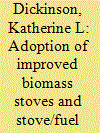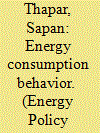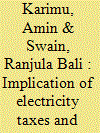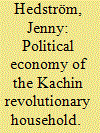|
|
|
Sort Order |
|
|
|
Items / Page
|
|
|
|
|
|
|
| Srl | Item |
| 1 |
ID:
168324


|
|
|
|
|
| Summary/Abstract |
In order to support transitions away from open-fire cooking and toward cleaner household energy systems, a better understanding of users’ technology adoption patterns and preferences is needed. This paper highlights key factors influencing use of two types of biomass-burning stoves provided through the REACCTING (Research on Emissions, Air quality, Climate, and Cooking Technology in Northern Ghana) randomized intervention study. We examine traditional and improved stove use over a two year follow up period, finding that the more basic rocket stove was used at a higher rate than the higher-tech gasifier stove. While stove use patterns varied by stove group, region, primary cook occupation, and socioeconomic status, use of traditional stoves remained high across most groups. Users perceived that improved stoves were less suitable for cooking a staple dish, Tuo Zaafi (TZ), and technical problems (e.g., battery failures with the gasifier stove) also limited the effectiveness of the intervention. Moving forward, household energy policies should prioritize a range of technologies that have potential to meet local needs while delivering meaningful health and/or environmental benefits, recognizing that stove and fuel “stacking” is likely to persist. A greater focus on markets and enabling environments is needed to support sustainable and scalable energy transitions.
|
|
|
|
|
|
|
|
|
|
|
|
|
|
|
|
| 2 |
ID:
125772


|
|
|
|
|
| Publication |
2013.
|
| Summary/Abstract |
People building their own houses have, at least theoretically, substantial autonomy when choosing, for example, a heating system and windows. In this article, focus is on the process of building new single-family houses and how energy efficiency and energy-efficient technology are incorporated into the building process. The conclusions emphasize energy as only one factor in housing purchase decisions. It is a big challenge to make low-energy building important to consumers. Consumer preferences for new products are unlikely to fully develop unless individuals have the opportunity to interact with them. It is difficult for consumers to know what to ask for if they lack experience of energy-efficient technologies. In the studied cases, the building codes and established standards became extremely decisive for how energy issues were included in the process. There is a need to change the design of incentives so as to make the least energy-efficient choice the most expensive. The most energy-efficient solution should be standard, and if the buyer wants to depart from that standard and build using less energy-efficient construction, then that should cost more.
|
|
|
|
|
|
|
|
|
|
|
|
|
|
|
|
| 3 |
ID:
117249


|
|
|
|
|
| Publication |
2013.
|
| Summary/Abstract |
It is difficult to control household energy consumption through regulation. From a policy standpoint, it is particularly challenging to identify the factors that influence people's actions. Moreover, whatever these factors are, they are unlikely to uniformly span multiple cities in the Asian region. In this paper, we conduct a survey of energy-saving behavior to clarify the differences among such factors across five major Asian cities. The results from these surveys in Dalian, Chongqing, Fukuoka, Bangkok, and Ho Chi Minh indicate that global warming consciousness, environmental behavior, and social interaction significantly affect energy-saving behavior. Income and age also had weak positive effects on energy-saving behaviors. Social interaction was strongly linked to energy-saving behaviors, particularly in the rural areas of Dalian and Chongqing. This result indicates that community-based activities impact energy-saving behaviors.
|
|
|
|
|
|
|
|
|
|
|
|
|
|
|
|
| 4 |
ID:
162325


|
|
|
|
|
| Summary/Abstract |
Both multi-person households and dense urban areas reduce per capita carbon dioxide (CO2) emissions by enabling people to share carbon-intensive goods within and between households. In this paper we estimate these household and urban economies in CO2 emissions using detailed household expenditure data for the United States. We then decompose these economies into their primary sources and investigate any potential rebound effects, or diseconomies. The results show that the bulk of household and urban economies come from reductions in emissions from residential energy use and private vehicle transportation. We also find some evidence of rebound effects, with both residential density and multi-person households increasing expenditures on air travel and restaurant meals in particular. These effects are small in comparison to the size of total net economies, suggesting that fears of large rebound effects or backfire effects may be overstated. These results further suggest that policies targeted at the provision of social and technological infrastructure, such as public transportation, mixed-use zoning, and public internet may be most effective in reducing the rural-urban divide in private vehicle emissions.
|
|
|
|
|
|
|
|
|
|
|
|
|
|
|
|
| 5 |
ID:
150801


|
|
|
|
|
| Summary/Abstract |
An increasing block tariff (IBT) has been implemented nationwide in the residential sector in China since 2012. However, knowledge about IBT design is still limited, particularly how to determine the electricity volume for the first block of an IBT scheme. Assuming the first block should be set based on some measure of electricity poverty; we attempt to model household electricity demand such that the range of basic needs can be established. We show that in Chinese households there exists a threshold for electricity consumption with respect to income, which could be considered a measure of electricity poverty, and the threshold differs between rural and urban areas. For rural (urban) families, electricity consumption at the level of 7th (5th) income decile households can be considered the threshold for basic needs or a measure of electricity poverty since household electricity demand in rural (urban) areas does not respond to income changes until after 7th (5th) income decile. Accordingly, the first IBT block for some provinces (e.g., Beijing) appears to have been set at a level that is too high. Over time however, given continued rapid growth, the IBT will begin to better reflect actual basic needs.
|
|
|
|
|
|
|
|
|
|
|
|
|
|
|
|
| 6 |
ID:
177485


|
|
|
|
|
| Summary/Abstract |
Counted among the top three energy consuming nations globally, India is working towards reducing its carbon emissions. Energy efficiency interventions offers a low-cost opportunity to achieve its climate goals. Though the Indian government has rolled out several energy efficiency schemes, the rate of decrease in energy intensity is lower than expectations. One of the desirable areas for intervention is influencing energy usage in households, which consumes a quarter of the total energy generated in India. The study analyzes energy usage behavior in households, using a mix of primary and secondary techniques. Key findings include seasonal consumption trends correlating with climatic parameters, use of inefficient equipment and rebound effect. Policy prescriptions include peak load clipping techniques like weatherization of homes, display of real-time consumption, rationalization of tariffs and expanded criteria for selecting equipment under ‘Star Rating Scheme’. The findings may be considered to improve energy policies towards influencing consumer behavior in India.
|
|
|
|
|
|
|
|
|
|
|
|
|
|
|
|
| 7 |
ID:
096107


|
|
|
|
|
| Publication |
2010.
|
| Summary/Abstract |
Energy security at the household level implies ensuring assured and regular supply of clean energy fuels at an affordable price for various household activities. Threat to physical availability of clean energy fuels for cooking and lighting is determined through various indicators such as dependence on traditional fuels and limited access to clean fuels. Energy insecurity translates into various adverse social impacts. Financial threat to energy security is indicated by expenses incurred on energy fuels and affordability of clean fuels. Households spend a major portion of their income on acquiring energy fuels; however, due to high price of clean fuels, they continue to depend on traditional and inefficient fuels. There is an urgent need to address factors that pose a threat to energy security at the household level. In this regard, measures taken by the government agencies and other institutions are also reviewed. The paper also suggests the regulatory and policy interventions required to address the energy security issues at the household level.
|
|
|
|
|
|
|
|
|
|
|
|
|
|
|
|
| 8 |
ID:
126562


|
|
|
|
|
| Publication |
2013.
|
| Summary/Abstract |
This paper attempts to measure consumers' perceived net benefits (or net costs) of energy-saving measures in using energy-consuming durable goods. Using the estimated net costs and the volume of CO2 reduced by the measures, a marginal abatement cost (MAC) curve for the average household's CO2 emissions is produced. An analysis using the curve suggests that in order to provide households with an incentive to take actions that can lead to CO2 emission reductions in using energy-consuming durables, a high level of carbon price is needed. In addition, a regression analysis reveals that the net benefits of the measures are larger for households that put a higher priority on energy saving, for those living in detached houses, for those with a smaller number of persons living together, and for those with less income. The result of the analysis using the MAC curve may suggest that promoting energy-saving behavior will require not only a policy to provide economic incentives but also interventions to influence psychological factors of household behavior.
|
|
|
|
|
|
|
|
|
|
|
|
|
|
|
|
| 9 |
ID:
190602


|
|
|
|
|
| Summary/Abstract |
A major challenge faced by policymakers has been determining appropriate subsidy amounts for household energy investments. This can result in inequitable support being either insufficient or excessive. Equitable reverse auctions offer a novel approach to address these issues. Households can bid an amount as a subsidy from the government that they require to go ahead with an energy investment. The lowest bids are successful in a reverse auction, allowing for cost-effective government support. The novel part is the pursuit of equity, as these auctions can occur separately for a pre-determined number of carefully chosen socio-economic groups. Equitable reverse auctions would lower inequality by design, relative to a common benchmark of equal subsidies, for a given government budget and environmental outcomes. Compared to a standard reverse auction, an equitable reverse auction will have greater equality by design but lower cost-effectiveness. However, the design of equitable reverse auctions is cost-effective within each socio-economic group. Non-additional subsidy spending would be reduced through reverse auctions. Equitable reverse auctions would be flexible to fit circumstances across countries, time, and technologies.
|
|
|
|
|
|
|
|
|
|
|
|
|
|
|
|
| 10 |
ID:
168350


|
|
|
|
|
| Summary/Abstract |
Households often make errors when self-assessing their housing wealth. By using the Chinese Households Finance Survey, we show that Chinese urban households systematically overestimate their home value. This bias is significantly related to household consumption: a one standard deviation increase in the extent of estimation bias is associated with a 10% increase in household consumption. Our main results are robust against a variety of robustness checks, e.g., taking into account the expectations of future home price, using the interviewee's estimation as the instrumental variable for the household self-estimation, implementing the hedonic model on an external data source to assess real homevalue, etc.. Further, we show that overestimated households are more likely to take risk in financial market, and have a larger amount of immediate and conspicuous consumption. These findings have policy implications for the recent debate about property tax, indicating the unintended consequences of property tax through providing more precise information about home value.
|
|
|
|
|
|
|
|
|
|
|
|
|
|
|
|
| 11 |
ID:
177121


|
|
|
|
|
| Summary/Abstract |
Reforming subsidies for fossil fuels is a challenging prospect for many governments. The impact of such a reform on households is a major concern for the government. This paper investigates the heterogeneous impacts of eliminating energy subsidies on households in China from direct and indirect perspectives. The results of the direct effects show that the removal of energy subsidies, particularly for removing electricity and gas subsidies, has a greater negative impact on the poor than on the rich. From an indirect perspective, this article shows that the lower the per capita disposable income, the higher the proportion of consumption to disposable income, and the greater the indirect impact of eliminating subsidies. Meanwhile, the impact is not only related to household income but consumer goods. Moreover, the indirect effects of eliminating subsidies on households differ across energy types. Specifically, eliminating electricity subsidies has the greatest effect on households, followed by transportation fuel and gas. We suggest that targeted supportive measures need to be taken towards the implementation of subsidy reform, particularly in countries with greater inequality, to minimize the negative effects on the poor.
|
|
|
|
|
|
|
|
|
|
|
|
|
|
|
|
| 12 |
ID:
088119


|
|
|
|
|
| Publication |
2009.
|
| Summary/Abstract |
During the late 1910s to early 1920s leaders in women's education sought to rationalize and modernize daily life through the promotion of 'domestic science'. Their writings, aimed at young educated middle class women, focused on ways to reform the running of their households to fit their changing roles as modern women and the changing conditions of Japanese society more generally. They assumed the sexual division of labour, but as reformers, they envisioned that middle class women would play a key role as household managers in the 'new era'. Following their instructions for efficient, scientific management of clothing, food and housing would ensure young women's social standing as exemplary middle class housewives, to the benefit of themselves personally as well as their families and the nation.
|
|
|
|
|
|
|
|
|
|
|
|
|
|
|
|
| 13 |
ID:
190597


|
|
|
|
|
| Summary/Abstract |
The current high electricity prices in the European Union (EU) are in part due to the high electricity taxes. United Nations’ Sustainable Development Goals (SDGs) Agenda with its global vision of attaining sustainable development especially seeks “to ensure universal access to affordable, reliable and modern energy services” (SDG 7). We investigate the synergy and trade-off effects of electricity taxes on sustainable development goals (SDGs) for the EU. Using panel data and panel vector autoregressive estimation approach, we find that higher household electricity taxes reduce both carbon emission and unemployment. Higher levels of industry electricity taxes, increase responsible production and consumption (SDG12) and reduces unemployment (SDG8). Furthermore, there is evidence for a strong synergy effect between electricity taxes, unemployment and carbon emission but a trade-off between tax and SDG9 (innovation and sustainable infrastructure). The taxes contribute more to the future variation of unemployment and responsible production and consumption in the EU, but these contributions are much larger for the industry as compared to the household sector. Our results confirm the double-dividend hypothesis, which implies that the policymakers can achieve environmental goals with higher electricity taxes, especially on household electricity. In the industrial sector, our findings suggest that there is a need for tax reform, to encourage innovation and adopt production processes that are less polluting to the environment.
|
|
|
|
|
|
|
|
|
|
|
|
|
|
|
|
| 14 |
ID:
126559


|
|
|
|
|
| Publication |
2013.
|
| Summary/Abstract |
This study examines the influences of financial and non-financial factors on electricity-conservation behaviour. A random sample of 236 Japanese households participated in the field experiment and the participants were offered two interventions, such as monetary rewards, depending on their reduction in electricity consumption and comparative feedback. The average saving rates of the (i) reward-intervention group (5.9%) and the (ii) reward with comparative feedback group (8.2%) are statistically larger than those of the (iii) control group (1.7%). Our study demonstrates the following. First, our econometric analysis confirmed a significant response by households to financial incentives but a more inconclusive response to the treatment that provided non-financial, additional information. Second, we found a positive influence of treatment externalities across time and households on energy saving. Third, there is a heterogeneous treatment effect in the reward-intervention group, with the households having a high New Ecological Paradigm (NEP) score being more likely to respond to the reward programme and save electricity than those that do not. Finally, and most interestingly, differences in responses to the questionnaire before and after the experiment suggest that the participants had underestimated the marginal costs of saving electricity before they actually started to do so.
|
|
|
|
|
|
|
|
|
|
|
|
|
|
|
|
| 15 |
ID:
122738


|
|
|
|
|
| Publication |
2013.
|
| Summary/Abstract |
Debates on the nexus between energy and development emphasise that access to modern energy carriers such as electricity improve development outcomes. This paper discusses the impacts of electrification on educational outcomes, gender and power relations, income generation, feelings of inclusion and exclusion and health in the village of Tsilitwa in the rural Eastern Cape, South Africa. It is based on an ethnographic grounded theory study conducted in 2009. The paper shows that the impacts of electricity may not match the benefits cited in the literature, and are not experienced in the same way by everyone in the community. The study uncovers the weakness of ignoring individual and group agency, and the complexity of social settings when advocating interventions to improve quality of life. The paper recommends that researchers and policymakers consider using ethnographic methods to complement other methods and reveal context and its implications on the energy-development nexus that other methods may not capture.
|
|
|
|
|
|
|
|
|
|
|
|
|
|
|
|
| 16 |
ID:
153250


|
|
|
|
|
| Summary/Abstract |
Applying a feminist political economy analysis of the Kachin military movement, this article will be mapping women's involvement in the armed uprising since the outbreak of the conflict in 1961, demonstrating the centrality of gender relations for the war. Using primary data, this article will show how the household provides essential support to the Kachin war effort in the shape of emotional, physical and material labour, thus underscoring the critical role played by women in maintaining the conflict. Examining the relationship between narratives of gendered insecurity in the community and notions of militarized duty, this article will argue that the Kachin armed forces have employed gendered notions of security and duty to legitimize and sustain the conflict. The importance of normative gender relations for providing labour and emotional and material support for the conflict will then be examined, showing how the household is situated as the nucleus of the armed revolution. The findings in this article thus reveal a need to take into account the relationship between the household and the armed conflict, arguing that the household is a site inseparably linked to nationalistic objectives, underpinning the economic and ideological structures of military movements. Interventions aiming at resolving the conflict in Kachin must therefore consider the importance of gender relations in upholding the political-economy infrastructure of the military movement.
|
|
|
|
|
|
|
|
|
|
|
|
|
|
|
|
| 17 |
ID:
106551


|
|
|
|
|
| Publication |
2011.
|
| Summary/Abstract |
This article explores the impact of labour force participation of Indian women on the consumption expenditure of their households. Field survey data were collected from working-wife and non-working wife households in Kerala, the state in India with the highest labour market participation of women in the organised sector. Differences in time-saving consumption expenditures of working and non-working wife households and different variables influencing consumption expenditures were researched. The study shows that among the variables which positively affect the time-saving consumption expenditure of the households, non-economic factors influence the time-saving consumption expenditure of the working-wife households more prominently than in non-working wife households.
|
|
|
|
|
|
|
|
|
|
|
|
|
|
|
|
|
|
|
|
|